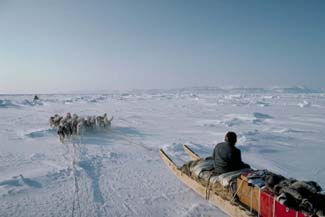In This Issue...
*
F.I.D.O.: Daniel Annanack
*
F.I.D.O.: Mark Brazeau and Qimmiit Utirtut
*
Wolf Problems in Kuujjuaq
*
Inuit Dogs of Mawson Station
*
Differences in Mushing: Greenland and Arctic Canada, Part II
*
Inuit Produced Information Resources
*
In the News
*
Book Review: 1000 Days with Sirius
*
Product Review: 3Mô Precise Skin Stapler
*
IMHO: A Time for Action
Navigating This
Site
Index of articles by subject
Index
of back issues by volume number
Search The
Fan Hitch
Articles
to download and print
Ordering
Ken MacRury's Thesis
Our
comprehensive list of resources
Talk
to The
Fan Hitch
The Fan
Hitch home page
ISDI
home page
Editor's/Publisher's Statement
Editor: Sue Hamilton
Webmaster: Mark Hamilton
The Fan Hitch welcomes your letters, stories, comments and suggestions. The editorial staff reserves the right to edit submissions used for publication.
Contents of The Fan Hitch are protected by international copyright laws. No photo, drawing or text may be reproduced in any form without written consent. Webmasters please note: written consent is necessary before linking this site to yours! Please forward requests to Sue Hamilton, 55 Town Line Rd., Harwinton, Connecticut 06791, USA or mail@thefanhitch.org.
This site is dedicated to the Inuit Dog as well as related Inuit culture and traditions. It is also home to The Fan Hitch, Journal of the Inuit Sled Dog.

Photo:
Nunavut Tourism
A Time for Action
by Mark Hamilton
This isn't going to be my most auspicious start as I'm compelled here, at the very beginning, to admit to a character flaw - I have a problem with patience. Specifically, my problem is that I don't have any. But life has a way of highlighting for us, each and to ourselves, what our character flaws are and why they are bad. So I've been made aware of this shortcoming, and I'm resolved to working on it. Of course, that doesn't mean that all of a sudden I've become a patient person.
My current problem with patience involves the future of the Inuit Sled Dog. My perception is that right now in arctic Canada the future of the ISD is stationary, as if it were standing at a crossroads of two possible futures. In one of these possible futures they regain their place in Canadian arctic life, in the other they don't. The ISD cannot remain stationary at this crossroads indefinitely. It must follow one of these paths. We don't know which one. We don't even know when this will happen. My problem? I want to know now how this is all going to turn out.
I hope you have already read, elsewhere in this issue, about the Qimmiit Utirtut project now underway in Kangiqsualujjuaq, Nunavik, as well as about its organizers. They have persevered in the face of a variety of challenges to launch this program. Their aim is to develop a viable population of pure ISDs and re-establish the breed as a working sled dog, in demand by mushers in Kangiqsualujjuaq.
In the March 2005 issue of The Fan Hitch you met Allen Gordon. Allen has been working to build a team of pure Inuit Sled Dogs in Kuujjuaq, Nunavik. He has an appreciation of the ISD and recognizes its place in Inuit culture. His goal is to own an entire team of pure ISDs and for others in Kuujjuaq to see and learn to appreciate them as well. His team has now developed to the point where he will begin doing sled dog tours in conjunction with Mahoosuc Guide Service of Newry, Maine this March.
In the September 9, 2005 Nunatsiaq News, Gordon O'Connor, the M.P. who speaks for the Conservatives on defense matters, stated that if his party headed up the government, they would expand the Canadian Rangers to patrol and maintain sovereignty in the Canadian Arctic. The Fan Hitch had suggested in our March 2005 Editorial that an expansion of the Canadian Rangers, modeled on the concept of the Danish military's Greenland Sirius Patrol, utilizing Inuit Sled Dogs (for the same reasons as listed by former Sirius Patrol Commander Palle Norit in his December 2004 The Fan Hitch interview), would be in the best interests of both Canada and the ISD.
The Canadian government has already directed the RCMP to investigate allegations pertaining to Inuit Dogs in the 1950s, 1960s and 1970s that have come to be referred to as the "dog slaughters". Regardless of any report's findings it seems reasonable to me to anticipate that the Ottawa government may want to take some actions seeking to resolve lingering ill will harbored by multiple generations of Inuit regarding this issue.
I choose to highlight these four events to demonstrate that there are things going on right now that suggest a revival of interest in ownership and use of Inuit Sled Dogs in the Canadian North; that there is hint of possible reconciliation over the 'old wounds' surrounding the dog slaughters issue; that there are enough things already going on now to indicate that the Inuit Dog could have a future in the Canadian Arctic. But it's not a sure thing. In fact, it may not even be the most likely outcome.
Now is not the time to sit around the camp stove and speculate on how great it would be if the Canadian government established a program to reconstitute the Inuit Sled Dog's numbers and future. Now is not the time for us to look for a consultant to come in and design a perfect five-point plan for re-integrating the Inuit Dog in the Canadian Arctic. The Inuit Sled Dog needs action, and in my opinion no one-size-fits-all plan is likely to be anywhere near as successful as supporting local efforts, based on local needs and local interests. We all need to connect with those needs and interests as the efforts in Kangiqsualujjuaq and Kuujjuaq have demonstrated. And the time is now.